IAP 2011: Sometimes the Work World is Just Like on TV
-
-
slice.mit.edu
Filed Under
Recommended
Guest blogger: Ben Shaibu '14 Alumnus host: Ed Sittler PhD '78

I’m currently externing at NASA Goddard Space Flight Center and the University of Maryland. I’m not sure if I completely knew what I was getting into by signing up for an externship, but it’s been a great experience. My MIT host is Dr. Ed Sittler PhD '78, and I work with him along with Dr. Dennis Chornay (whose son is an MIT student!), and Professor Michael Coplan of the University of Maryland.
I started my first day at the University of Maryland–College Park by meeting with Professor Coplan. When he started explaining the project, I worried my “freshman-ness” would start to show. We were going to be working on an ion mass spectrometer, specifically, a Wien filter that would involve opposing magnetic and electric fields in such a way that their resultant forces would be equal and opposite in order to select for particles of specific velocities and, through some additional filters, mass as well. Simple enough, right? I managed to grasp the gist of the project and hoped I wasn’t going to be grilled too hard on it (luckily, I wasn't).
Professor Coplan took me on a tour of the lab and showed me everything from a few of the magnets to my very own workstation. Then we met with Edd Cole, a machinist at UMD who would be helping create some of the parts for the project. I learned we were having trouble tracking down a specific part we needed. I thought waiting on parts only happened in TV. From then on, I knew I was going to learn a lot about the work world.
Eventually, we went to Goddard to meet up with other project members. At NASA I learned more about the filter and actually got to see it (or, rather, the vacuum chamber it was in). I spoke with Mark Shapiro and learned how we needed to verify the data he was getting. I met Dr. Dennis Chornay, who turned out to be Person #1 to speak to in tracking down the part we needed. He led us to Person #2—Alberto, who said we needed to speak with someone who wasn’t in that day. So Alberto gave us a tour of the facility. It was awesome to see all the different machines and parts, from giant saws to a nifty 3-D printer that could create models in instants (well…relatively).
At Goddard the next day, I worked on simulating the ions flying into the Wien filter with a program called SIMION. Learning to use SIMION was tricky (and I even made a small error that resulted in me having to redo about a day’s work), but I feel pretty comfortable with it now. I also found out I would get a chance to build pieces of the filter, assuming we had enough, and that I would be designing an apparatus to hold the magnets and test and determine their strengths.
It sounded like a full workload to me, but I guess that would be lesson two about the work world—get ready to work on more than one thing. Most of my time was pretty busy and I learned how to use a variety of different programs. I increased my sketching knowledge by looking at an engineering design book and using a program called Graphite.
I mainly work in one of “my offices,” but I’ve had some good chances to get out, whether it was going to see Edd Cole and discuss changes to the design (we’re currently on the third and, we hope, final phase), going to eat at Joe’s food truck, visiting the student union, or talking to neighboring grad students and using their microwave. The people at Goddard and Maryland have been pretty nice. I was even able to tour one of NASA’s huge server rooms with literally hundreds of component computers. The fans in the room were intense, and after feeling the heat the computers generated, I knew why.
One of the most memorable experiences of the externship was when I was cleaning some rings for the Wien filter with ethanol and Dr. Chornay repeatedly came to make sure I wasn’t drinking any. “You’re not old enough yet,” he joked.
On Wednesday night, Dr. Sittler, his wife, and I went to an alumni Toast to IAP event that also celebrated the kick-off of the 150th anniversary of MIT. It was a pretty good trip and the food wasn’t half bad. The place seemed pretty lively as people reminisced, listened to music, made new contacts, and posed with a cutout of William Barton Rogers. Getting to meet a variety of alumni and seeing how they were using their MIT experience was great. There were science writers, consultants, scientists, engineers, business executives, and even a few other undergrads. And, it was great to drive past the White House on the way back.
I’m having a wonderful experience so far, but I wish I could have more time to answer questions and finish up projects. Will the part arrive before I leave? How will the spectrometer turn out? Will my simulations match up with Mark Shapiro’s tests? Will Dr. Chornay tell more jokes?
Hopefully I’ll be able to get a good bit of work done before it’s time to head back to the ’T'ute. While being here has been a great learning experience, I can’t wait to get back to MIT!






